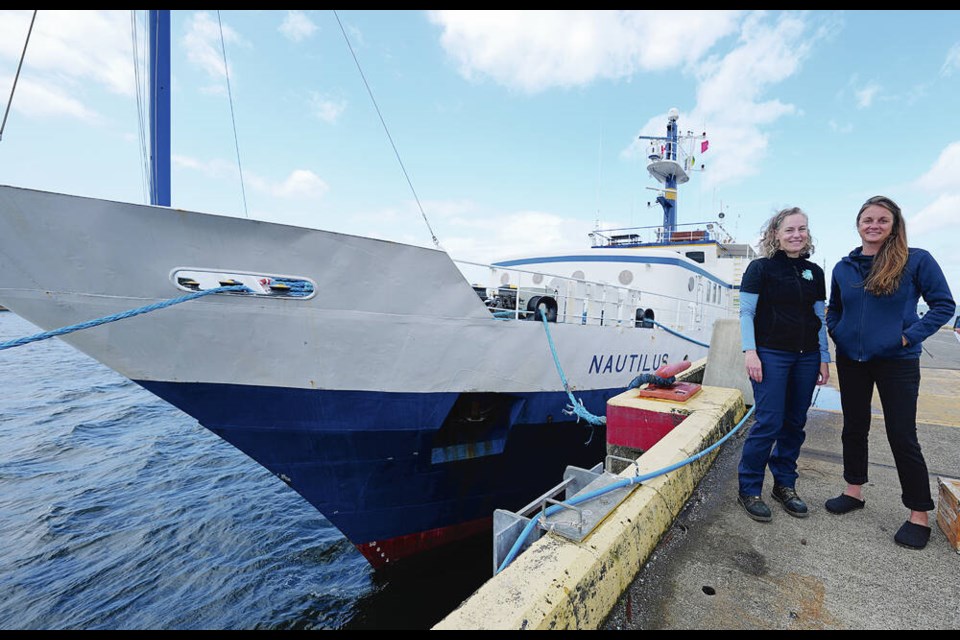Scientists will use remotely operated vehicles equipped with cameras to descend up to two kilometres to see the effects of hundreds of earthquakes that rumbled over the Pacific Ocean seafloor off the Island in March.
And the public is invited to come along via a live internet stream.
Scientists are boarding the ship EV Nautilus at Patricia Bay on Friday for a 21-day expedition to service and upgrade equipment along Ocean Network sa国际传媒’s 800-kilometre subsea-cabled loop of observatories, which has been providing researchers with data from the depths of the ocean since 2017.
EV Nautilus is owned by Robert Ballard, the oceanographer who discovered the Titanic and founded Ocean Exploration Trust, which partners with the University of Victoria-based Ocean Networks sa国际传媒 for servicing expeditions on the network.
Ocean Networks sa国际传媒’s observatory loop starts in Alberni Inlet and covers an 800-kilometre circle in the Pacific, stretching out as far as 240 kilometres.
Observatories record everything from new sea life and ocean temperatures and currents to tectonic plate activity.
The loop of power and fibre optic cables is connected to scientific instruments and cameras and about 12,000 sensors, which provide real-time data.
The crew of 52 is especially eager to see the NEPTUNE Endeavour Observatory, where fissures in the sea floor have created hydrothermal vents, and a marine-protected area around the chimneys that form from heat and minerals.
On March 6, a “swarm” of earthquakes hit the site — 200 per hour at the peak, including one measuring 4.5-magnitude.
Meghan Paulson, director of observatory digital operations for Ocean Networks sa国际传媒, said teams will use advancing technologies in cameras and mapping to investigate the increased earthquake activity at a junction of the Juan de Fuca and Pacific tectonic plates.
“We may see newly formed seafloor, captured in high definition,” she said. “So we’re pretty excited about what we might find.”
The remotely operated vehicles, called Hercules and Atalanta, will check on sensors, cameras and other instruments and, in some cases, deploy new ones in what Ocean Networks sa国际传媒 scientists call one of the “most hostile environments on Earth.”
They will collect biological and geological samples and look for unique marine life and deep-sea ecosystems, particularly around the hydrothermal vent field, which has been pushing heat and magma to the ocean floor.
The March 6 earthquake event was the highest earthquake activity at the Endeavour site since 2005. The spike could be a sign of “impending magmatic rupture,” a natural phenomenon that forms new ocean floor, said Zoe Krauss, a marine seismology student at the University of Washington.
As tectonic plates separate, cracks form on the seafloor and are filled periodically by magma reaching 800 C rising from the Earth’s crust. The magma cools rapidly and solidifies into new oceanic crust.
The Endeavour Hydrothermal Vents Marine Protected Area is well known for its diverse and strange marine life. No natural light penetrates there, so high-powered lights on the remote vehicles will give scientists a clear picture of tube worms, crabs and micro-organisms.
Underwater earthquakes have the potential to not only topple the sulfide chimneys, but alter the way fluids travel beneath vent systems, changing chemistry and temperatures, and leading to sea life being displaced and reorganized, say scientists.
In addition to visiting the Endeavour site, the expedition team will swap out equipment at four other sites along the cabled route, including a “whale fall” near the Clayoquot Slope site — an area where a dead whale sank to the ocean floor and a camera was positioned to watch the creatures that feed on the carcass.
“It’s a really dynamic and diverse environment,” said Allison Fundis, chief operating officer of the Ocean Exploration Trust.
She said the Ocean sa国际传媒 Network covers vast ranges of topography from the dark zones and thermal vents to tectonic plates and near-shore environments like the whale-fall site.
“Whale falls create their own ecosystems as different organisms come in at different stages, so it’s fascinating to study,” she said.
It’s the eighth year the trust has partnered with Ocean Networks sa国际传媒 using the 68-metre EV Nautilus. The ship operates 24 hours with a crew ranging from operators and engineers to educators and video specialists.
Two fuel trucks filled the EV Nautilus tanks on Tuesday and seven large pallets of food were loaded.
“There’s always somebody up working, which helps us with our shared vision about bringing everything we find to the broader public,” said Fundis. “It’s great to share as we’re seeing it for the first time with anyone watching live.”
Ocean Exploration Trust and Ocean Networks sa国际传媒 share all of their data from expeditions and cabled networks with researchers, decision-makers and anyone with an interest in the deep ocean.
ONC said the information helps advances in scientific discovery, marine safety, earthquake detection and notification and ocean-based climate change mitigation.
Anyone interested in exploring the ocean in real time can go to , a live streaming 24/7 interactive portal for seafloor expeditions, or
>>> To comment on this article, write a letter to the editor: [email protected]



